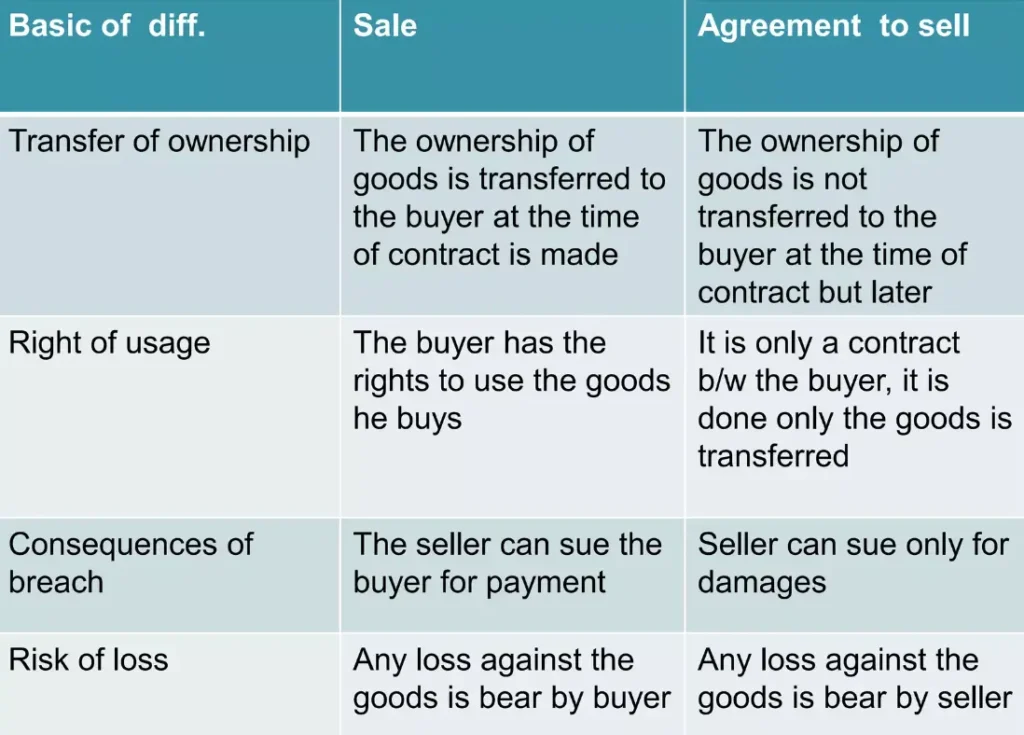Introduction
When engaging in business transactions, it’s crucial to grasp the distinctions between a sale and an agreement to sell. Though they might seem similar, these terms carry significant legal differences that impact the transfer of ownership, risk, and obligations.
What is a Sale?
A sale refers to a transaction where the ownership of goods is immediately transferred from the seller to the buyer. This transfer is definitive and binding, and it involves the exchange of goods for a price. According to Section 4(1) of the Sale of Goods Act, a sale is a present and complete transfer of property.
Key Features of a Sale
- Immediate Transfer of Ownership: The moment the sale is made, the buyer gains ownership of the goods.
- Risk Transfer: The risk associated with the goods shifts to the buyer as soon as the sale is completed.
- Binding Contract: A sale is a finalized contract, enforceable by law.
- Existing Goods: Typically involves goods that are already owned or possessed by the seller.
What is an Agreement to Sell?
An agreement to sell is a future commitment to transfer ownership of goods, contingent on certain conditions being met. This agreement outlines the terms and conditions for the future sale.
Key Features of an Agreement to Sell
- Future Transfer of Ownership: Ownership remains with the seller until the specified conditions are fulfilled.
- Risk Remains with Seller: Until the transfer is complete, the seller bears the risk of any damage or loss to the goods.
- Conditional Contract: This is an ongoing arrangement, dependent on future events.
- Future Goods: Often involves goods that will be available at a later date or are subject to future conditions.
Differences Between Sale and Agreement to Sell

Timing of Ownership Transfer:
- Sale: Ownership is transferred immediately.
- Agreement to Sell: Ownership is transferred in the future upon meeting specified conditions.
Risk Responsibility:
- Sale: Risk passes to the buyer immediately.
- Agreement to Sell: Risk remains with the seller until the goods are transferred.
Nature of Contract:
- Sale: A completed and binding contract.
- Agreement to Sell: An ongoing and conditional agreement.
Goods Involved:
- Sale: Usually involves existing goods.
- Agreement to Sell: This can involve future goods or goods to be acquired later.
Legal Implications
Understanding the legal implications of each type of transaction is essential for businesses to manage risk and protect their interests.
- Section 6(1): Highlights that a sale involves existing goods, whereas an agreement to sell pertains to future goods.
- Section 8: Covers scenarios where goods perish after an agreement to sell but before the sale, emphasizing the seller’s responsibility until the transfer.
- Section 9: Discusses price determination, noting that in a sale, the price is fixed immediately, while in an agreement to sell, it may be contingent on future circumstances.
Practical Examples
Example 1: Immediate Sale You buy a laptop from a store. The ownership and risk transferred to you as soon as the transaction is complete. If the laptop gets damaged after the purchase, the loss is yours.
Example 2: Agreement to Sell You pre-order a new smartphone that will be released next month. The seller agrees to transfer ownership to you upon release and payment. Until then, the seller bears the risk of any issues with the smartphone.
Conclusion
The primary difference between a sale and an agreement to sell lies in the timing of the ownership transfer. In a sale, the transfer is immediate, along with all associated risks and responsibilities. In contrast, an agreement to sell is a future promise, conditional on specific terms being met. For businesses, understanding these distinctions is vital to managing risk and ensuring clear and enforceable contracts.
FAQs
1. What happens if the goods are damaged after an agreement to sell but before the actual sale?
The seller bears the risk and responsibility for any damage until the ownership is transferred to the buyer.
2. Can an agreement to sell be converted into a sale?
Yes, once the conditions outlined in the agreement are met, the agreement to sell becomes a sale.
3. Why is it important to differentiate between a sale and an agreement to sell?
Differentiating between the two helps in understanding when ownership and risk transfer, which is crucial for legal and financial clarity in transactions.
Also Read: Malicious Prosecution In Tort
Reference: shiksha.com